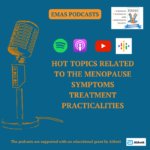Host: Welcome to today’s podcast. Practicalities: Sequential or Continuous. This episode is part of a podcast series supported by Abbott. The content is solely the responsibility of EMAS, the European Menopause and Andropause Society. All our episodes are available in English, Spanish, Mandarin, and Russian, and you can find them on any of the most popular podcast platforms.
In today’s episode, Marco Gambacciani, Secretary of the Italian Menopause Society and Board Member of the European Menopause and Andropause Society, will help us understand the use of Sequential or Continuous Combined Hormone Replacement Therapy.
Marco Gambacciani: Both sequential or continuous combined estrogen and progesterone administrations are valid options to treat normal post-menopausal women with an intact uterus because we need to underline that non-hysterectomized women require progestogen administrated for at least 12–14 days in a sequential regimen, and daily in a continuous combined regimen, to minimize or even reduce the risk of endometrial hyperplasia and endometrial cancer associated with the unopposed estrogen exposure after menopause.
So, when should we choose the sequential, and when should we choose the continuous combined regimen? The choice may depend on the clinical characteristics and personal preferences of any given woman. Whether the clinician needs to know that differences in patient characteristics, age, and personal history are important in selecting one type of HRT or another. Progestogen generally makes the difference in terms of potential side effects and adverse events.
We should say that evidence from large observational studies and case-control studies suggest that micronized progesterone and dydrogesterone are unlikely to increase the risk of venous thromboembolism and are associated with a lower risk of breast cancer compared to other synthetic progestogens.
Therefore, we choose progestin also when we are choosing the type sequential or the type continuous combined. We should say that in early postmenopausal women, sequential estro-progestin treatment may lead to irregular bleeding. Can be even welcomed and even opportune in young women. Mainly if they are suffering from POI, Premature Ovarian Insufficiency. And irregular bleeding can be considered suitable even in women in their late 40s and early 50s. Conversely, in elderly post-menopausal women after months or after years from the last menstrual period, continuous combined hormone replacement therapy can be the treatment of choice because, with a continuous combined estro-progestin administration, we avoid unwanted periodic bleedings.
For the long-term run, the long-term effects of hormonal replacement therapy, we should say that no major differences are present in terms of osteoporosis, cardiovascular disease, and neuroprotective effects. Let me rephrase it with, there are no sufficient data to establish if a sequential or continuous progestogen administration, in conjunction with estrogen can make any difference in the long-term run regarding osteoporosis and cardiovascular disease.
Where are the differences? For sure, the administration of sequential progestin should be avoided in women reporting premenstrual syndrome or endometriosis or fibroids, or heavy menstrual bleeding in their personal history. Since sequential progestin exposure can stimulate again, bleeding, headache, or pelvic pain and therefore in these patients a low-dose continuous combined preparation is more indicated than a sequential one.
There were, in the past, some studies showing that sequential combined hormonal replacement therapy lasting more than five years can be associated with a small increase in the risk of endometrial cancer and this risk is inversely proportional to the number of days of progestogen is given.
We have to consider also that the endometrial potency of different progestogens can make a difference. However, no solid data comparing different progestogens are present, and we must counsel our patients to take progestogens for at least 12–14 days every month while they are treated with estrogens every day, in the sequential fashion.
For sure, we know that continuous combined estrogen and progestogen has a neutral effect or even an effect in reducing the risk of endometrial hyperplasia and endometrial cancer risk.
By the way, the WHI demonstrated that the continuous combined estro-progestin administration can even reduce the risk of endometrial cancer. We have also to mention that colon cancer has been demonstrated to be reduced in women treated with oral combined and hormonal replacement therapy.
So, at the end of the day, we should say that the choice between sequential and continuous combined hormone replacement therapy depends on the patient’s characteristics, age, and preferences. As always, as Gynecologists, we need to know the different opportunities to treat the right woman with the right choice at the right time.
Thank you very much for your attention.
Host: Today, Professor Marco Gambacciani discussed the use of sequential or continuous combined hormone replacement therapy. Thank you for listening to today’s episode. We hope it will be valuable for your clinical and research practice. Stay safe.
[END]


